A Novel Energy Efficient Threshold Based Algorithm for Wireless Body Sensor Network
Abstract
:1. Introduction
2. Related Works
3. Fail-Proof Lifetime Enhancement (FPLE) Algorithm
3.1. Markov Model
3.2. Battery Model
3.3. Radio Model
= Eeleck + Empkd4; d > d0
3.4. Threshold T* Policy Framework
| Terminologies | |
| λ | Rate at which the packets are arrived |
| µ | Rate at which the packets are serviced |
| ρ | Utilization factor |
| T | Threshold number of packets |
| ETX | Amount of energy consumed during transmit mode in J |
| ETR | Amount of energy consumed due to synchronization and switching in J |
| E[C] | Average cycle duration |
| E[T] | Average energy consumption of node as a function of T in J |
| E[I] | Sensor node’s average duration in Idle state |
| Cy | Mean number of cycles |
| L | Average number of packets |
| PI | Idle-state probability |
- (a)
- T* Node during normal operation condition
- (b)
- T* Model under node fault condition (Communication failure)where
| Algorithm 1: FPLE routing |
| BEGIN PROCESS While(1) Cross-correlate the ECG and HB value with normal data IF cross correlation coefficient εr < ε1 subject under normal condition; reserved Energy RE = ERE; // compute reserved energy from Equation (9); While1 (1) receive I am alive packet from all nodes; delay(); if I am alive packet not received or RE < ERE alarm; end if end while1 if1 VECG > VPR ECG sensor works as a CH Route the PR & ECG data towards sink if T = T* go to if1; else PR sensor works as a CH Routes the ECG data towards sink if T = T*; end if1 else IF cross correlation coefficient ε1 < εr < ε2 Check node fault(); Wakeup all idle nodes subject under above normal condition; Reserved Energy RE = 0; Implanted node selects high energy and high signal strength node; All the other nodes directly send data towards sink following star topology; else Check node fault(); Wakeup all idle nodes subject under abnormal condition; All nodes send data directly to sink; end IF end while |
| Algorithm 2: FPLE Node Fault Check |
| Begin node fault Check data rate; Check value limit Check cross correlation coefficient with neighbor primary sensor node; End |
3.5. Proof for FPLE Being Thermal-Aware
4. Results and Discussion
- All SNs are deployed in the ROI.
- The nodes are treated as energy starving.
- The nodes are assumed to be either a Full Function or reduced function device.
- All nodes in nature are static in their respective positions
5. Conclusions
Author Contributions
Funding
Institutional Review Board Statement
Informed Consent Statement
Data Availability Statement
Acknowledgments
Conflicts of Interest
References
- Kanagachidambaresan, G.R.; SarmaDhulipala, V.R.; Vanusha, D.; Udhaya, M.S. Matlab based modelling of body sensor network using ZigBee protocol. In Proceedings of the International Conference on Computational Intelligence and Information Technology (CCIS 250), Pune, India, 7–8 November 2011; Springer: Berlin/Heidelberg, Germany, 2011; pp. 773–776. [Google Scholar]
- Akyildiz, I.F.; Su, W.; Sankarasubramaniam, Y.; Cayirci, E. Wireless sensor networks: A survey. Comput. Netw. 2002, 38, 393–422. [Google Scholar] [CrossRef] [Green Version]
- Kanagachidambaresan, G.R.; Chitra, A. Fail safe fault tolerant mechanism for wireless body sensor network (WBSN). Wirel. Pers. Commun. 2015, 80, 247–260. [Google Scholar] [CrossRef]
- Javaid, N.; Abbas, Z.; Farid, M.S.; Khan, Z.A.; Alrajeh, N. M-attempt a new energy-efficient routing protocol in wireless body area sensor networks. Procedia Comput. Sci. 2013, 19, 224–231. [Google Scholar] [CrossRef] [Green Version]
- Ahmad, A.; Javaid, N.; Qasim, U.; Ishfaq, M.; Khan, Z.A.; Alghamdi, T.A. RE-ATTEMPT: A new energy-efficient routing protocol for wireless body sensor networks. Int. J. Distrib. Sens. Netw. 2014, 10, 464010. [Google Scholar] [CrossRef]
- Abdur, M.R.; Hong, C.; Lee, S. Data-centric multi objective QoS-aware routing protocol for body sensor networks. Sensors 2011, 11, 917–937. [Google Scholar] [CrossRef]
- Kanagachidambaresan, G.R.; Chitra, A. TA-FSFT Thermal Aware Fail Safe Fault Tolerant algorithm for Wireless Body Sensor Network. Wirel. Pers. Commun. 2016, 90, 1935–1950. [Google Scholar] [CrossRef]
- Braem, B.; Latre, B.; Blondia, C.; Moerman, I.; Demeester, P. Analysing and improving reliability in multi-hop body sensor networks. Adv. Internet Technol. 2009, 2, 152–161. [Google Scholar]
- Fleischman, R.J.; Lundquist, M.; Jui, J.; Newgard, C.D.; Warden, C. Predicting Ambulance Time of Arrival to the Emergency Department Using Global Positioning System and Google Maps. Prehosp. Emerg. Care 2013, 17, 458–465. [Google Scholar] [CrossRef] [Green Version]
- Breen, N.; Woods, J.; Bury, G.; Murphy, A.W.; Brazier, H. A national census of ambulance response times to emergency calls in Ireland. Emerg. Med. J. 2000, 17, 392–395. [Google Scholar] [CrossRef] [Green Version]
- Kanagachidambaresan, G.R.; SarmaDhulipala, V.R.; Udhaya, M.S. Markovian model based trustworthy architecture. In Procedia Engineering; ICCTSD; Elsevier: Amsterdam, The Netherlands, 2011. [Google Scholar]
- SarmaDhulipala, V.R.; Kanagachidambaresan, G.R.; Chandrasekaran, R.M. Lack of power avoidance: A fault classification based fault tolerant framework solution for lifetime enhancement and reliable communication in wireless sensor network. Inf. Technol. J. 2012, 11, 719. [Google Scholar]
- Ababneh, N.; Timmons, N.; Morrison, J.; Tracey, D. Energy balanced rate assignment and routing protocol for body area networks. In Proceedings of the 26th International Conference on the Advanced Information Networking and Applications Workshops (WAINA’12), Fukuoka, Japan, 26–29 March 2012; pp. 466–471. [Google Scholar]
- Ben Elhadj, H.; Chaari, L.; Kamoun, L. A survey of routing protocols in wireless body area networks for healthcare applications. Int. J. E-Health Med. Commun. 2012, 3, 118. [Google Scholar] [CrossRef]
- Titouna, C.; Aliouat, M.; Gueroui, M. FDS: Fault Detection Scheme for Wireless Sensor Networks. Wirel. Pers. Commun. 2016, 86, 549–562. [Google Scholar] [CrossRef]
- Hanson, M.A.; Powell, H.C., Jr.; Barth, A.T.; Ringgenberg, K.; Calhoun, B.H.; Aylor, J.H.; Lach, J. Body area sensor networks: Challenges and opportunities. Computer 2009, 42, 58–65. [Google Scholar] [CrossRef]
- Liu, H.; Nayak, A.; Stojmenović, I. Fault-Tolerant Algorithms/Protocols in Wireless Sensor Networks. In Guide to Wireless Sensor Networks; Springer: London, UK, 2009; pp. 261–291. [Google Scholar]
- Mhatre, V.; Rosenberg, C.P.; Kofman, D.; Mazumdar, R.; Shroff, N. A minimum cost heterogeneous sensor network with a lifetime constraint. IEEE Trans. Mob. Comput. 2005, 1, 4–15. [Google Scholar]
- Du, X.; Guizani, M.; Xiao, Y.; Chen, H.-H. Two tier secure routing protocol for heterogeneous sensor networks. IEEE Trans. Wirel. Commun. 2007, 6, 3395–3401. [Google Scholar] [CrossRef]
- Polastre, J.; Hill, J.; Culler, D. Versatile low energy media access for wireless sensor networks. In Proceedings of the 2nd International Conference on Embedded Networked Sensor Systems, Baltimore, MD, USA, 3–5 November 2004; pp. 95–107. [Google Scholar]
- Maheswar, R.; Jayaparvathy, R. Performance Analysis of Cluster based Sensor Networks Using N-Policy M/G/1 Queueing Model. Eur. J. Sci. Res. 2011, 58, 177–188. [Google Scholar]
- Maheswar, R.; Jayaparvathy, R. Performance Analysis of Fault Tolerant Node in Wireless Sensor Network. In Proceedings of the Third International Conference on Advances in Communication, Network, and Computing—CNC 2012, Chennai, India, 24 February 2012; Springer: Berlin/Heidelberg, Germany, 2012. [Google Scholar]
- Darwish, A.; Kanagachidambaresan, G.R.; Maheswar, R.; Laktharia, K.I.; Mahima, V. Buffer Capacity Based Node Life Time Estimation in Wireless Sensor Network. In Proceedings of the 8th IEEE International Conference on Computing, Communication and Networking Technologies (ICCCNT), Delhi, India, 3–5 July 2017. [Google Scholar]
- Jayarajan, P.; Maheswar, R.; Kanagachidambaresan, G.R. Modified Energy Minimization Scheme Using Queue Threshold Based on Priority Queueing Model. Clust. Comput. 2017, 22, 12111–12118. [Google Scholar] [CrossRef]
- Nageswari, D.; Maheswar, R.; Kanagachidambaresan, G.R. Performance analysis of cluster based homogeneous sensor network using energy efficient N-policy (EENP) model. Clust. Comput. 2018, 22, 12243–12250. [Google Scholar] [CrossRef]
- Jayarajan, P.; Maheswar, R.; Sivasankaran, V.; Vigneswaran, D.; Udaiyakumar, R. Performance Analysis of Contention Based Priority Queuing Model Using N-Policy Model for Cluster Based Sensor Networks. In Proceedings of the Seventh IEEE International Conference on Communication and Signal Processing (ICCSP), Chennai, India, 3 April 2018. [Google Scholar]
- Maheswar, R.; Jayarajan, P.; Vimalraj, S.; Sivagnanam, G.; Sivasankaran, V.; Amiri, I.S. Energy Efficient Real Time Environmental Monitoring System Using Buffer Management Protocol. In Proceedings of the Ninth IEEE International Conference on Computing, Communication and Networking Technologies (ICCCNT), Bengaluru, India, 10–12 July 2018. [Google Scholar]
- Jayarajan, P.; Maheswar, R.; Kanagachidambaresan, G.R.; Sivasankaran, V.; Balaji, M.; Das, J. Performance Evaluation of Fault Nodes Using Queue Threshold Based on N-Policy Priority Queueing Model. In Proceedings of the Ninth IEEE International Conference on Computing, Communication and Networking Technologies (ICCCNT), Bengaluru, India, 10–12 July 2018. [Google Scholar]
- Sampathkumar, A.; Mulerikkal, J.; Sivaram, M. Glowworm swarm optimization for effectual load balancing and routing strategies in wireless sensor networks. Wirel. Netw. 2020, 26, 4227–4238. [Google Scholar] [CrossRef]
- Sampathkumar, A.; Murugan, S.; Rastogi, R.; Mishra, M.K.; Malathy, S.; Manikandan, R. Energy Efficient ACPI and JEHDO Mechanism for IoT Device Energy Management in Healthcare. In Internet of Things in Smart Technologies for Sustainable Urban Development; Kanagachidambaresan, G.R., Maheswar, R., Manikandan, V., Ramakrishnan, K., Eds.; EAI/Springer Innovations in Communication and Computing; Springer: Cham, Switzerland, 2020. [Google Scholar] [CrossRef]
- Murugan, S.; Sampathkumar, A.; Kanaga Suba Raja, S.; Ramesh, S.; Manikandan, R.; Gupta, D. Autonomous Vehicle Assisted by Heads up Display (HUD) with Augmented Reality Based on Machine Learning Techniques. In Virtual and Augmented Reality for Automobile Industry: Innovation Vision and Applications. Studies in Systems, Decision and Control; Hassanien, A.E., Gupta, D., Khanna, A., Slowik, A., Eds.; Springer: Cham, Switzerland, 2022; Volume 412. [Google Scholar] [CrossRef]
- Banuselvasaraswathy, B.; Sampathkumar, A.; Jayarajan, P.; Sheriff, N.; Ashwin, M.; Sivasankaran, V. A Review on Thermal and QoS Aware Routing Protocols for Health Care Applications in WBASN. In Proceedings of the 2020 International Conference on Communication and Signal Processing (ICCSP), Chennai, India, 28–30 July 2020; pp. 1472–1477. [Google Scholar] [CrossRef]
- Jayarajan, P.; Kanagachidambaresan, G.R.; Sundararajan, T.V.P.; Sakthipandi, K.; Maheswar, R.; Karthikeyan, A. An Energy Aware Buffer Management (EABM) Routing Protocol for WSN. J. Supercomput. 2018, 76, 4543–4555. [Google Scholar] [CrossRef]
- Ugochukwu, N.S.; Goyal, S.B.; Arumugam, S. Blockchain-Based IoT-Enabled System for Secure and Efficient Logistics Management in the Era of IR 4.0. J. Nanomater. 2022, 2022, 7295395. [Google Scholar] [CrossRef]
- Bedi, P.; Goyal, S.B.; Rajawat, A.S.; Shaw, R.N.; Ghosh, A. Application of AI/IoT for Smart Renewable Energy Management in Smart Cities. In AI and IoT for Smart City Applications. Studies in Computational Intelligence; Piuri, V., Shaw, R.N., Ghosh, A., Islam, R., Eds.; Springer: Singapore, 2022; Volume 1002. [Google Scholar] [CrossRef]
- Sharma, S.; Rani, M.; Goyal, S.B. Energy Efficient Data Dissemination with ATIM Window and Dynamic Sink in Wireless Sensor Networks. In Proceedings of the 2009 International Conference on Advances in Recent Technologies in Communication and Computing, Kottayam, India, 27–28 October 2009; pp. 559–564. [Google Scholar] [CrossRef]
- Sharma, S.; Goyal, S.B.; Qamar, S. Four-Layer Architecture Model for Energy Conservation in Wireless Sensor Networks. In Proceedings of the 2009 Fourth International Conference on Embedded and Multimedia Computing, Jeju, Korea, 10–12 December 2009; pp. 1–3. [Google Scholar] [CrossRef]


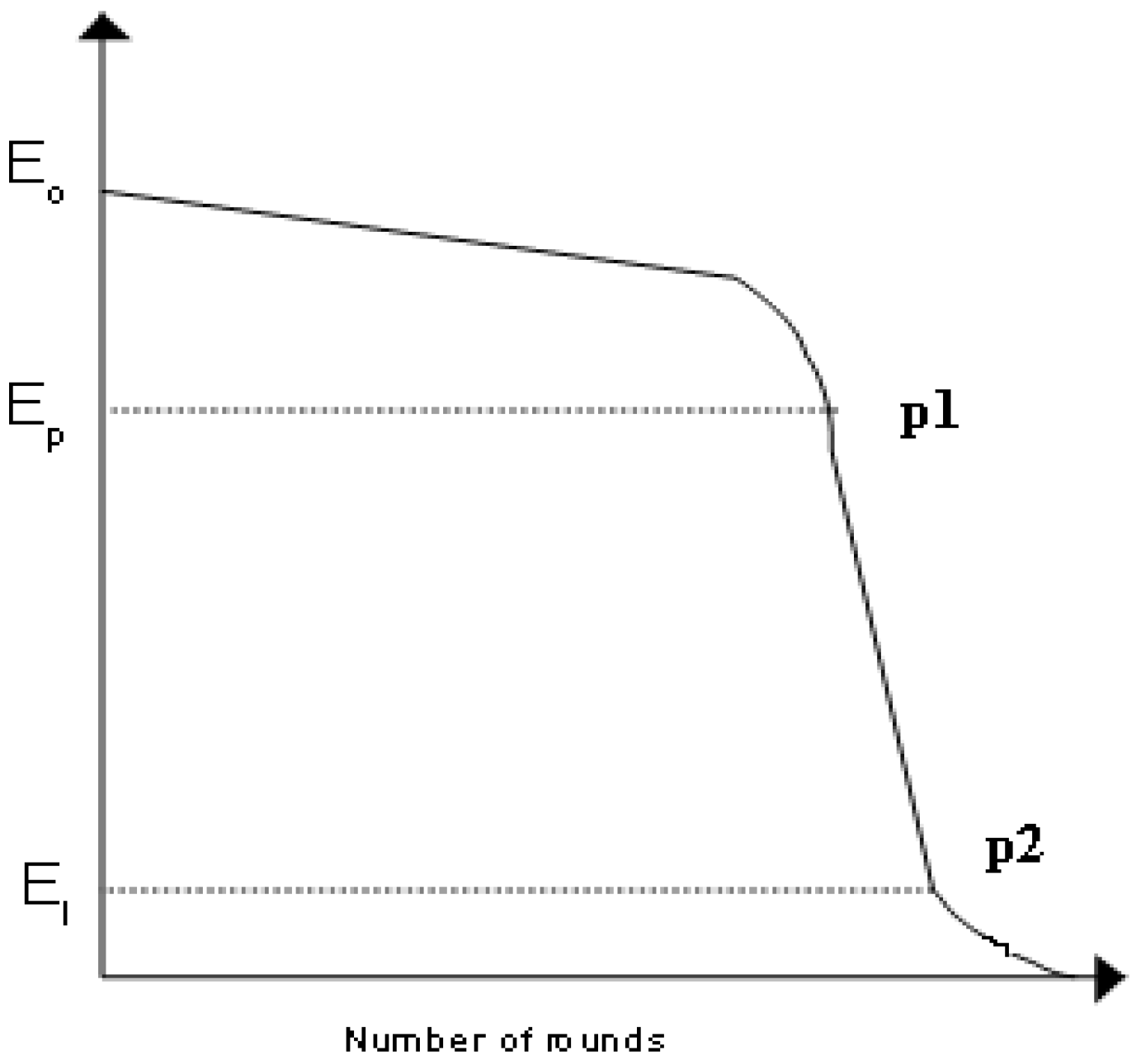


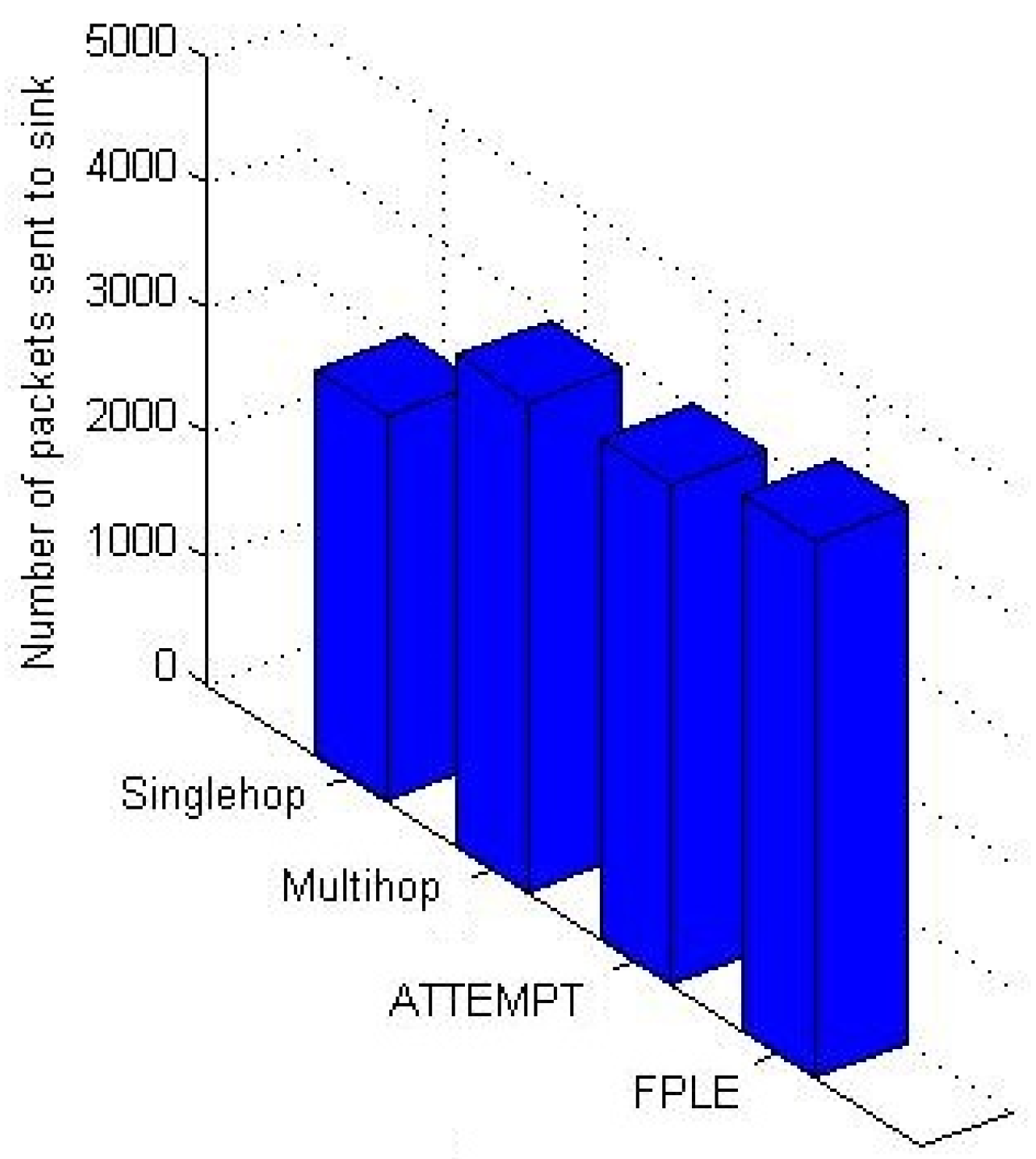

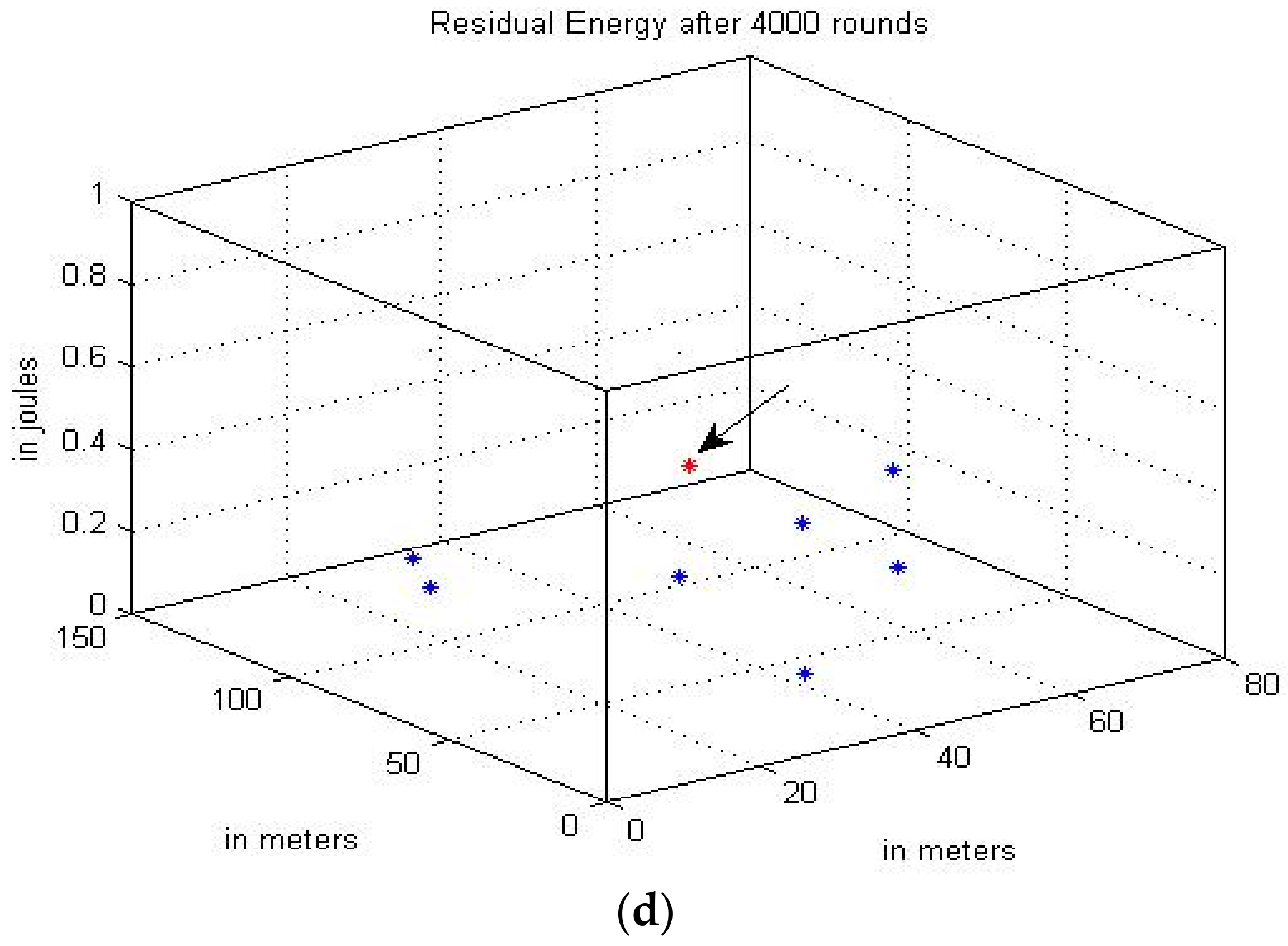
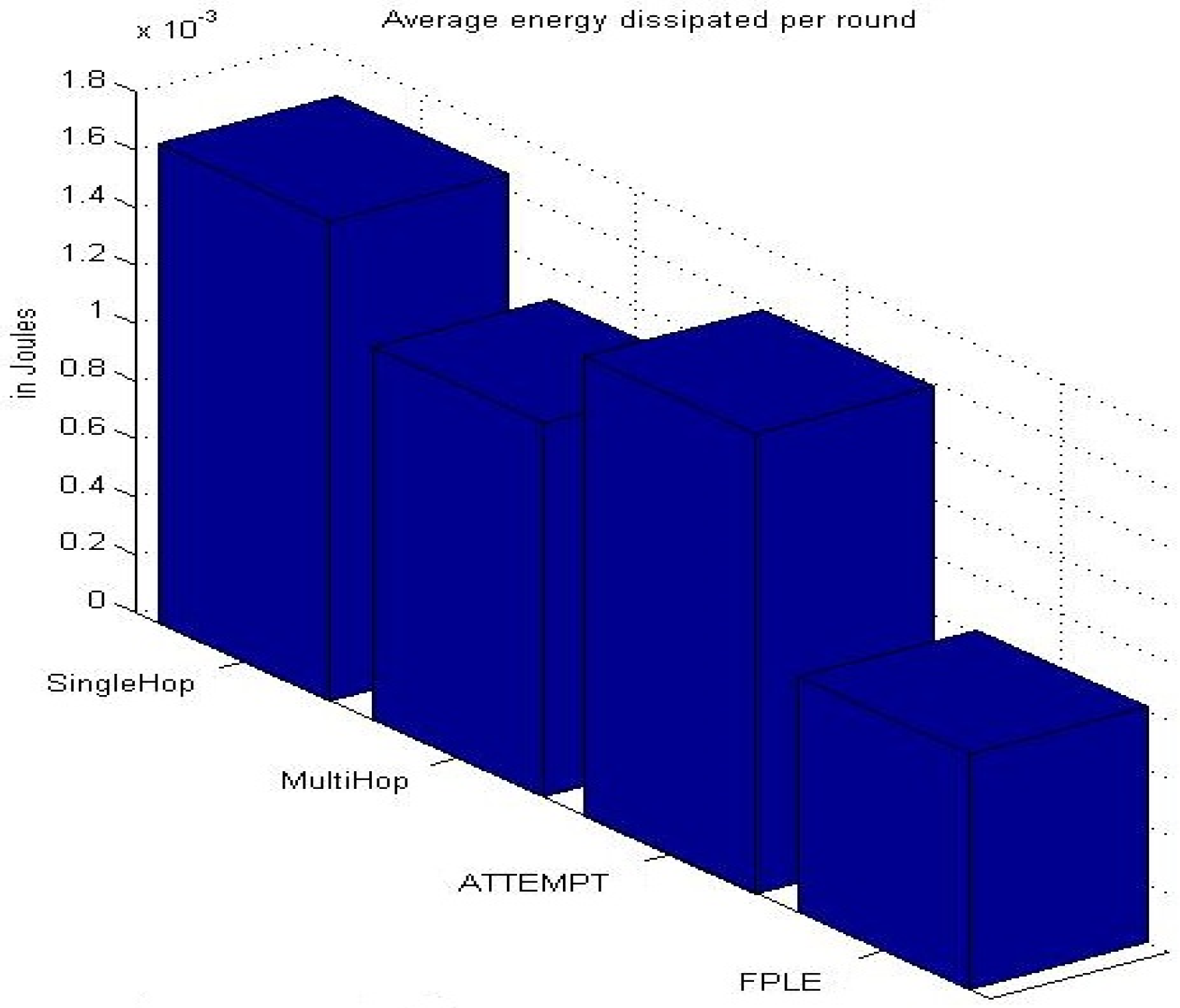
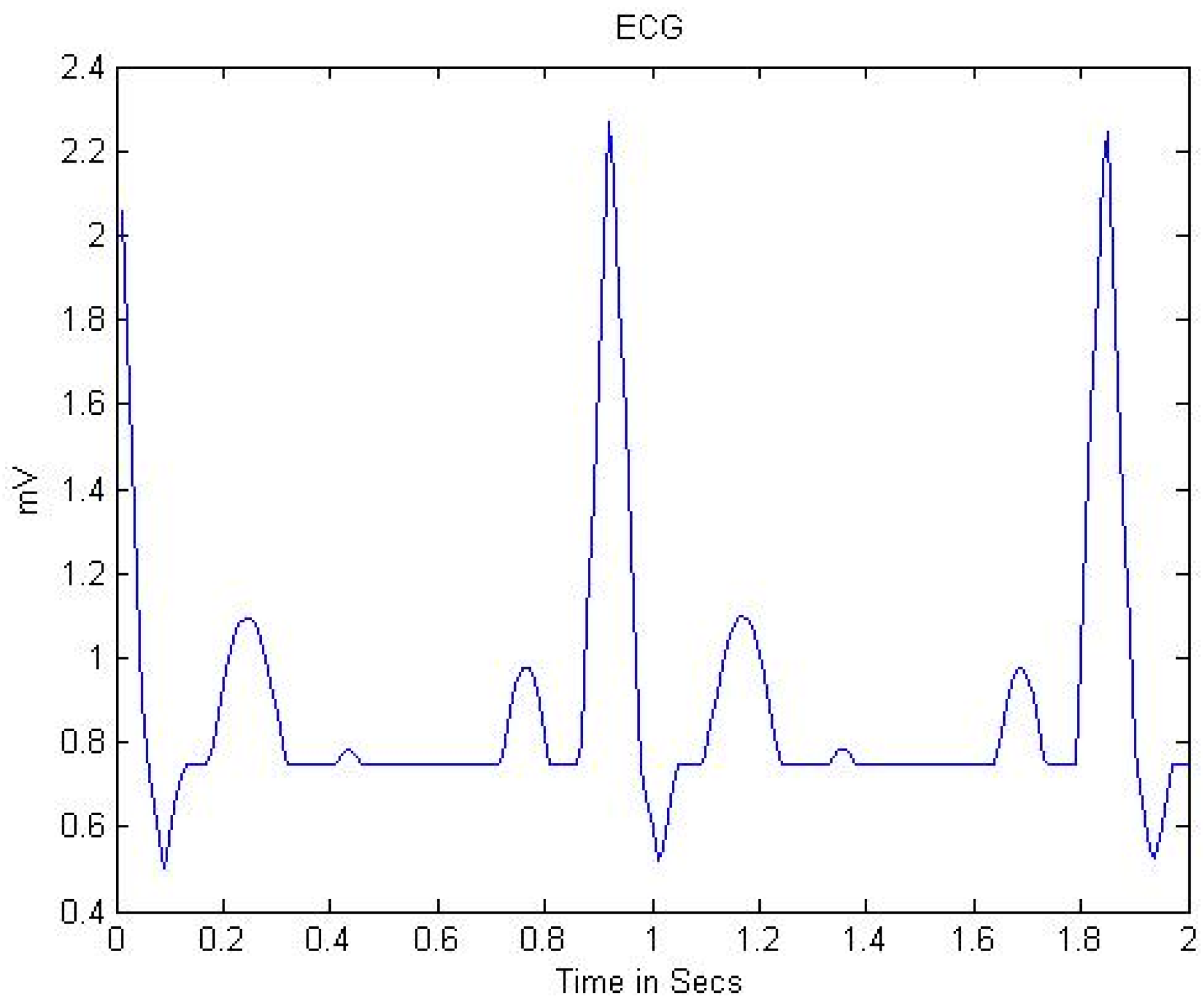


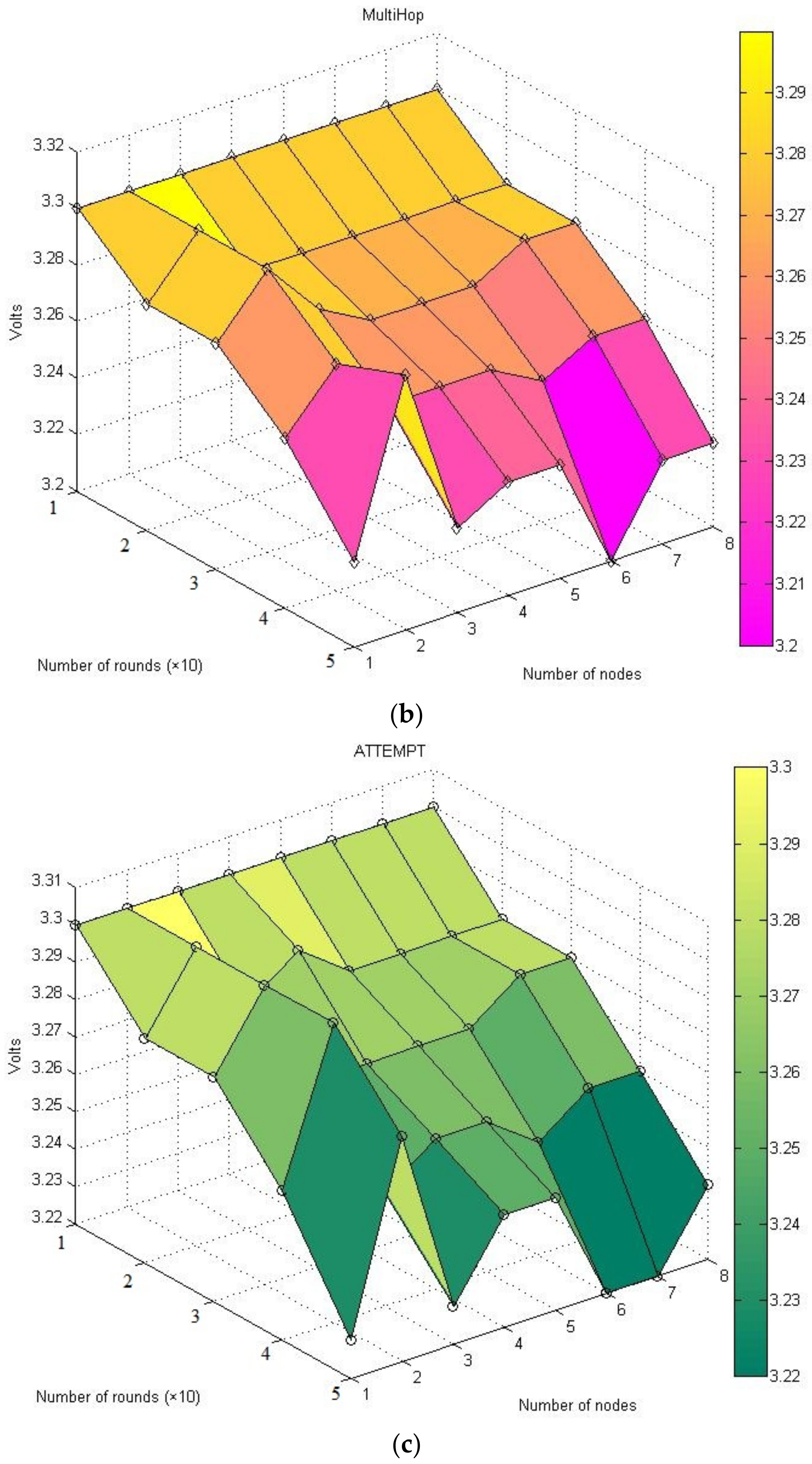
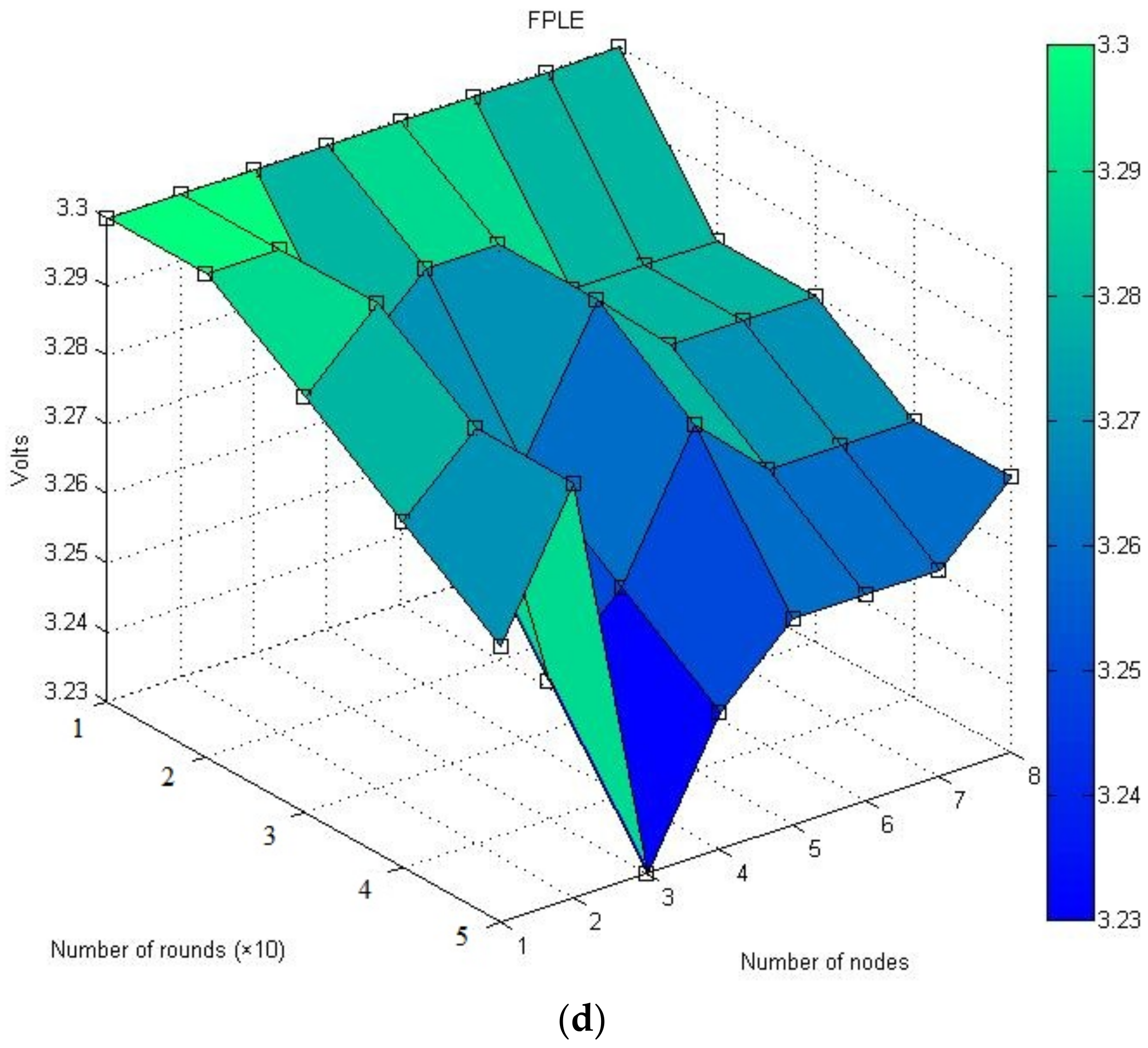
| Sensor Type | Data Rate in bps | Power Consumption (H-High/L-Low) | Privacy (H-High/L-Low) | Bandwidth in Hz |
|---|---|---|---|---|
| Blood pressure | 16 | H | H | 0–150 |
| Temperature | 120 | L | L | 0–1 |
| EMG | 300 k | L | H | 0–10,000 |
| ECG | 288 k | L | H | 100–1000 |
| EEG | 43.2 k | L | H | 0–1 |
| Node-ID | x Location | y Location |
|---|---|---|
| 1 | 20.00 | 110.00 |
| 2 | 60.00 | 120.00 |
| 3 | 10.00 | 80.00 |
| 4 | 70.00 | 80.00 |
| 5 | 30.00 | 50.00 |
| 6 | 50.00 | 60.00 |
| 7 | 30.00 | 10.00 |
| 8 | 50.00 | 30.00 |
| 9 (CMU) | 40.00 | 80.00 |
| Network Parameters | Value |
|---|---|
| Network Area | 160 × 80 cm2 |
| Number of SNs | 8 + 1 (CMU) |
| Eelec | 50 nJ/bit |
| Efs | 10 pJ/bit-m2 |
| Energy at time 0 | 0.5 Joule |
| Probability of being a CH | 0.1 |
| Size of normal data | 2000 bytes |
| Size of critical data | 4000 bytes |
| Size of header field | 50 bytes |
| Parameter | Value |
|---|---|
| Network area | 80 cm × 160 cm |
| Number of SNs | 8 + 1 (CMU) |
| Base station place | 40, 210 |
| Battery capacity | 2300 mAh, 3.3 terminal voltage |
| Probability to be opted as a CH | 0.1 |
| Transceiver protocol | Zigbee protocol (XBee) transceivers) |
| Body sensor data | ECG, Temperature (data from an implanted node) |
| Processing module | Arduino Uno |
| Protocol | Energy Saving | Emergency Situation Handling | Thermal-Aware | Fault Awareness |
|---|---|---|---|---|
| SingleHop | × | √ | × | × |
| MultiHop | √ | × | √ | × |
| ATTEMPT | √ | √ | √ | × |
| FPLE | √ | √ | √ | √ |
Publisher’s Note: MDPI stays neutral with regard to jurisdictional claims in published maps and institutional affiliations. |
© 2022 by the authors. Licensee MDPI, Basel, Switzerland. This article is an open access article distributed under the terms and conditions of the Creative Commons Attribution (CC BY) license (https://creativecommons.org/licenses/by/4.0/).
Share and Cite
Arumugam, S.K.; Mohammed, A.S.; Nagarajan, K.; Ramasubramanian, K.; Goyal, S.B.; Verma, C.; Mihaltan, T.C.; Safirescu, C.O. A Novel Energy Efficient Threshold Based Algorithm for Wireless Body Sensor Network. Energies 2022, 15, 6095. https://doi.org/10.3390/en15166095
Arumugam SK, Mohammed AS, Nagarajan K, Ramasubramanian K, Goyal SB, Verma C, Mihaltan TC, Safirescu CO. A Novel Energy Efficient Threshold Based Algorithm for Wireless Body Sensor Network. Energies. 2022; 15(16):6095. https://doi.org/10.3390/en15166095
Chicago/Turabian StyleArumugam, Suresh Kumar, Amin Salih Mohammed, Kalpana Nagarajan, Kanagachidambaresan Ramasubramanian, S. B. Goyal, Chaman Verma, Traian Candin Mihaltan, and Calin Ovidiu Safirescu. 2022. "A Novel Energy Efficient Threshold Based Algorithm for Wireless Body Sensor Network" Energies 15, no. 16: 6095. https://doi.org/10.3390/en15166095






